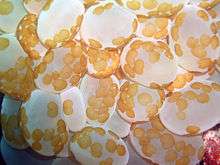Acoelomorpha
| Acoelomorpha | |
|---|---|
 | |
| Waminoa sp. on Plerogyra sp.. | |
| Scientific classification | |
| Kingdom: | Animalia |
| Phylum: | Xenacoelomorpha |
| Subphylum: | Acoelomorpha Ehlers, 1985 |
| Classes | |
Acoelomorpha is a subphylum of very simple and small soft-bodied animals with planula-like features which live in marine or brackish waters. They usually live between grains of sediment, swimming as plankton, or crawling on other organisms, such as algae and corals.[1] With the exception of two acoel freshwater species, all known Acoelomorphs are marine.[2]
Classification
Traditionally, based on morphological characters, acoelomorphs were considered to belong to the phylum Platyhelminthes, which was at that time seen as the sister group to all other bilaterian phyla.[3] However, a series of molecular studies since the end of the 20th century demonstrated that they belong to a separate phylum, most likely as basal bilateral animals slightly more derived than cnidarians.[4][5][6]
The true position of Xenacoelomorpha was not yet well defined, as some results showed them as belonging to the deuterostomes. However, reanalyses and increased taxon and gene sampling in phylogenomic analyses favor the placement of Xenacoelomorpha as sister group to Nephrozoa with good support.[7][8][9]
Acoels have a statocyst, which presumably helps them orient to gravity. Their soft bodies make them difficult to classify.[10]
Anatomy
Acoelomorphs resemble flatworms in many respects, but have a simpler anatomy, not even having a gut. Like flatworms, they have no circulatory or respiratory systems, but they also lack an excretory system. They lack body cavities (acoelomate structure), a hindgut or an anus.[1]
The epidermal cells of acoelomorphs are unable to proliferate, a feature that is only shared with rhabditophoran flatworms and was for some time considered a strong evidence for the position of Acoelomorpha within Platyhelminthes. In both groups, the epidermis is renewed from mesodermal stem cells.[11]
The nervous system of acoelomorphs is formed by a set of longitudinal nerve bundles beneath the ciliated epidermis. Close to the anterior end, these bundles are united by a ring comissure, but do not form a true brain, although it is hypothesized that such organization was the precursor of the cephalization of the nerve system in more derived bilaterians.[12] After decapitation, such a "brain" (rather, a cerebroid ganglion) regenerates in a few weeks.[13]
The sensory organs include a statocyst and, in some cases, very primitive pigment-spot ocelli capable of detecting light.[14]
Acoelomorphs are simultaneous hermaphrodites, but have no gonads and no ducts associated with the female reproductive system. Instead, gametes are produced from the mesenchymal cells that fill the body between the epidermis and the digestive vacuole.[14]
References
- 1 2 Cannon, L. R. G. (1986) Turbellaria of the World. A guide to families and genera. Brisbane, Queensland Museum, 136 p.
- ↑ Harzsch, Steffen; Purschke, Günter (2016-01-01). Structure and evolution of invertebrate nervous systems. Oxford University Press. pp. 56–61. ISBN 978-0-19-968220-1. OCLC 951605913.
- ↑ Conway-Morris, S.; George, J. D.; Gibson R.; Pllatt, H. M. (1985) The Origins and relationships of lower invertebrates. Oxford, Clarendon Press, 397 p.
- ↑ Baguñà, J.; Riutort, M. (2004). "Molecular phylogeny of the Platyhelminthes". Canadian Journal of Zoology. 82 (2): 168–193. doi:10.1139/z03-214.
- ↑ Baguñà, Jaume; Riutort, Marta (2004). "The dawn of bilaterian animals: the case of acoelomorph flatworms". BioEssays. 26 (10): 1046–57. doi:10.1002/bies.20113. PMID 15382134.
- ↑ Ruiz-Trillo, Iñaki; Riutort, Marta; Fourcade, H. Matthew; Baguñà, Jaume; Boore, Jeffrey L. (2004). "Mitochondrial genome data support the basal position of Acoelomorpha and the polyphyly of the Platyhelminthes". Molecular Phylogenetics and Evolution. 33 (2): 321–32. doi:10.1016/j.ympev.2004.06.002. PMID 15336667.
- ↑ Edgecombe, G. D.; Giribet, G.; Dunn, C. W.; Hejnol, A.; Kristensen, R. M.; Neves, R. C.; Rouse, G. W.; Worsaae, K.; Sørensen, M. V. (2011). "Higher-level metazoan relationships: Recent progress and remaining questions". Organisms Diversity & Evolution. 11 (2): 151–172. doi:10.1007/s13127-011-0044-4.
- ↑ Srivastava, M.; Mazza-Curll, K. L.; Van Wolfswinkel, J. C.; Reddien, P. W. (2014). "Whole-Body Acoel Regeneration is Controlled by Wnt and Bmp-Admp Signaling". Current Biology. 24 (10): 1107–13. doi:10.1016/j.cub.2014.03.042. PMID 24768051.
- ↑ Cannon, Johanna Taylor; Vellutini, Bruno Cossermelli; Smith, Julian; Ronquist, Fredrik; Jondelius, Ulf; Hejnol, Andreas (2016). "Xenacoelomorpha is the sister group to Nephrozoa". Nature. 530 (7588): 89–93. doi:10.1038/nature16520. PMID 26842059.
- ↑ Petrov, A.; Hooge, M.; Tyler, S. (2006). "Comparative morphology of the bursal nozzles in acoels (Acoela, Acoelomorpha)". Journal of Morphology. 267 (5): 634–648. doi:10.1002/jmor.10428. PMID 16485278.
- ↑ Michalak, Pawel; Egger, Bernhard; Steinke, Dirk; Tarui, Hiroshi; De Mulder, Katrien; Arendt, Detlev; Borgonie, Gaëtan; Funayama, Noriko; Gschwentner, Robert; Hartenstein, Volker; Hobmayer, Bert; Hooge, Matthew; Hrouda, Martina; Ishida, Sachiko; Kobayashi, Chiyoko; Kuales, Georg; Nishimura, Osamu; Pfister, Daniela; Rieger, Reinhard; Salvenmoser, Willi; Smith, Julian; Technau, Ulrich; Tyler, Seth; Agata, Kiyokazu; Salzburger, Walter; Ladurner, Peter (2009). "To Be or Not to Be a Flatworm: The Acoel Controversy". PLoS ONE. 4 (5): e5502. doi:10.1371/journal.pone.0005502. PMC 2676513. PMID 19430533.
- ↑ Perea-Atienza, E.; Gavilan, B.; Chiodin, M.; Abril, J. F.; Hoff, K. J.; Poustka, A. J.; Martinez, P. (2015). "The nervous system of Xenacoelomorpha: a genomic perspective". Journal of Experimental Biology. 218 (4): 618–28. doi:10.1242/jeb.110379. PMID 25696825.
- ↑ Sprecher, Simon G.; & al. (2015). "Functional brain regeneration in the acoel worm Symsagittifera roscoffensis". Biology Open. 4 (12): 1688–1695. doi:10.1242/bio.014266.
- 1 2 Barnes, Robert D. (1982). Invertebrate Zoology. Philadelphia, PA: Holt-Saunders International. p. 229. ISBN 0-03-056747-5.
.jpg)